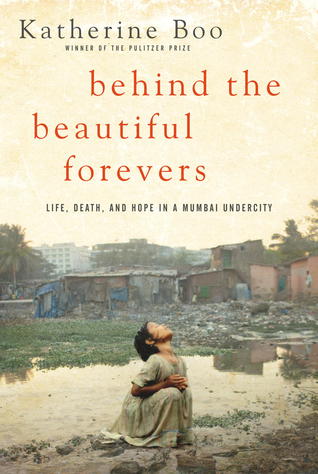In the weeks leading up to the February 28 announcement of the 2012 NBCC award winners, Critical Mass highlights the thirty finalists. Today in our series, NBCC board member Elizabeth Taylor offers an appreciation of nonfiction finalist Behind the Beautiful Forevers: Life, Death, and Hope in a Mumbai Undercity (Random House) by Katherine Boo.
 A minutely researched, compassionately reported account of waste-pickers in an Indian slum, Behind the Beautiful Forevers is wise and empathetic book, written with precision and grand sweep.
A minutely researched, compassionately reported account of waste-pickers in an Indian slum, Behind the Beautiful Forevers is wise and empathetic book, written with precision and grand sweep.
Katherine Boo focuses on a tiny “sumpy plug of a slum,” Annawadi, born when construction workers began to squat on government land on the road to Mumbai’s International Airport. About 3,000 people crammed into 355 huts, with an unknown number of feral pigs and water buffalo roaming about. The slum bordered a lake of sewage, with residents existing by sifting through the nearby airport hotels’ trash, looking for items like plastic bottles and beer bottle tops that could be sold to recycling plants.
Yet by Indian standards, this slum was not considered poor, despite the fact that some residents trapped frogs and rats for meals. The makeshift town sat on a stretch of road, Boo writes, “where new India and old India collided and made new India late.”
It may be a cliché to say that Katherine Boo writes like a novelist, but it happens to be the most fitting analogy possible. She never makes herself part of the story, instead she carefully metabolizes her written notes, video recordings, audio tapes and 3,000 public records, and transforms her reporting into one of the most heartbreaking books imaginable.
Recognized with a Pulitzer Prize and MacArthur Genius Award, Boo is regarded as one of the most gifted journalists of her generation. With Behind the Beautiful Forevers, she has written an ensemble drama featuring characters like Asha, a wily mother who works political and police connections, determined to send her daughter, Manju to college, and Fatima, an irascible one-legged woman.
At the heart of “Behind the Beautiful Forevers” is Abdul Husain, a small and jumpy 19-year-old who knew about one thing: trash. When an incident involving Fatima sends Abdul spiraling downward through the Indian criminal justice system, Boo reveals a spectacle of bribes and injustice that seems to Abdul like it’s a market the same as the garbage he organizes and sells.
Katherine Boo writes with empathy as Annawadi comes alive on the page and Abdul leaves a permanent impression on readers as he passes from boy to man in the years that Boo worked on the book. He tries to be honorable, to make enough money to traffic only in legal trash, but he realizes that men don’t make distinctions between good and bad, truth and falsehood.
Despite his efforts to sell only legal trash, he realizes that he cannot make a living for his family that way. “For some time I tried to keep the ice from melting,” he explains to Boo, telling her: “But now I’m just becoming dirty water, like everyone else. I tell Allah I love Him immensely, immensely. But I tell Him I cannot be better, because of how the world is.”
Links:

